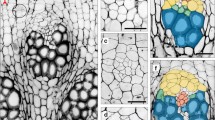Abstract
The effect of up to 48 h of flooding on the development of roots of Sesbania cannabina an0d S. rostrata seedlings was examined in a pot experiment. Light microscopy revealed that the outermost cells of the phellogen of the taproot of S. cannabina expanded and elongated during the first 12 h of flooding. After 18 h, the outermost of these regions was composed of cells that had expanded radially direction to form a spongy zone inside the endodermis. These elongated cells were radially connected to each other and formed the secondary aerenchyma surrounding the stele of taproot. While those histological alterations were not observed in S. rostrata, the number of layers of cells originating in the pericycle increased slightly, but elongation of the cells was not found during the first 18 h of flooding. After 36 h of flooding, cell elongation was also detected as outer layers of the phellogen. The delayed response to flooding in aerenchyma production in S. rostrata was compensated by immediate development of adventitious roots on submerged parts of the hypocotyl.
Similar content being viewed by others
References
Arikado H 1975 Aerenchyma Formation and Flood-Tolerance in Crops. Oriental Press, Mie, Japan. 149 pp. (in Japanese)
Armstrong W 1979 Aeration in higher plants. Adv. Bot. Res. 7, 225-332.
Bacanammwo M and Purcell L C 1999 Soybean root morphological and anatomical traits associated with acclimation to flooding. Crop Sci. 39, 143-149.
Becker M, Ladha J K and Ottow J C G 1990 Growth and N2 fixation of two stem-nodulating legumes and their effect as green manure on lowland rice. Soil Biol. Biochem. 22, 1109-1119.
Becker M and George T 1995 Nitrogen fixing response of stemand root-nodulating Sesbania species to flooding and mineral nitrogen. Plant Soil 175, 189-196.
Blom C W P M 1999 Adaptations to flooding stress: from plant community to molecule. Plant Biol. 1, 261-273.
Drew M C, Jackson M B and Giffard S C 1979 Ethylene-promoted rooting and development of cortical air-spaces (aerenchyma) in roots may be adapted responses to flooding in Zea mays L. Planta 147, 83-88.
Dreyfus B L and Dommergues Y R 1981 Nitrogen-fixing nodules induced by Rhizobium on the stem of the tropical legume Sesbania rostrata. FEMS Microbiol. Lett. 10, 313-317.
Etherington J R 1984 Comparative studies of plant growth and distribution in relation to waterlogging: 10. Differential formation of adventitious roots and their experimental excision in Epilobium hirsutum and Chamerion angustifolium. J. Ecol. 72, 389-404.
Gibberd M R, Colmer T D and Cocks P S 1999 Root porosity and oxygen movement in waterlogging-tolerant Trifolium tomentosum and-intolerant Trifolium glomeratum. Plant Cell Environ. 22, 1161-1168.
Itoh J, Shioya T, Nouguchi R and Kogano K 1992 Improvement of soil properties by cultivation of tropical leguminous crops in heavy clayey paddy fields. Bull. Hokuriku Natl. Agric. Exp. Stn. 34, 27-41 (in Japanese).
Jackson M B and Drew M C 1984 Effects of flooding on growth and metabolism of herbaceous plants. In Flooding and Plant Growth. Ed. T T Kozlowsky. Academic Press, Orlando, Florida, USA.
Jackson M B and Armstrong W 1999. Formation of aerenchyma and process of plant ventilation in relation to soil flooding and submergence. Plant Biol. 1, 274-287.
Justin S H F W and Armstrong W 1987 The anatomical characteristics of roots and plant response to soil flooding. New Phytol. 106, 465-495.
Ladha J K, Pareek R P and Becker M 1992 Stem nodulating legume-Rhizobium symbiosis and its agronomic use in lowland rice. Adv. Soil Sci. 20, 147-192.
Lempe J, Stevens K J and Peterson R L 2001 Shoot responses of six Lythraceae species to flooding. Plant Biol. 3, 186-193.
Longstreth D J and Borkhsenious O N 2000 Root cell ultrastructure in developing aerenchyma tissue of three wetland species. Ann. Bot. 86, 641-646.
Mochizuki T, Takahashi U, Shimamura S and Fukuyama M 2000 Secondary aerenchyma formation in hypocotyl in summer leguminous crops. Jpn. J. Crop Sci. 69, 69-73 (in Japanese).
Moog P R 1998 Flooding tolerance of Carex species. 1. Root structure. Planta 207, 189-198.
Schussler E and Longstreth D J 2000 Changes in cell structure during the formation of root aerenchyma in Sagittaria lancifolia (Alismataceae). Amer. J. Bot. 87, 12-19.
Scott D H and Wager H 1888. On the floating-root of Sesbania aculeata, Pers.. Ann. Bot. 1: 308-314.
Seago J L Jr, Peterson C A, Kinsley L J and Broderick J 2000a Development and structure of the root cortex in Caltha palustris L. and Nymphaea odorata Ait.. Ann. Bot. 86, 631-640.
Seago J L Jr, Peterson C A and Enstone D E 2000b Cortical development in roots of the aquatic plant Pontederia cordata (Pontederiaceae). Amer. J. Bot. 87, 1116-1127.
Sena-Gomes A R and Kozlowski T T 1980 Growth responses and adaptations of Fraxinus pennsylvanica seedlings to flooding. Plant Physiol. 66, 267-271.
Shiba H and Daimon H 2002 Growth, nitrogen fixation and root morphology of two Sesbania species grown under flooded condition. Kinki J. Crop Sci. Breed. 47, 41-45.
Stevens K J, Peterson R L and Stephenson G R 1997 Morphological and anatomical responses of Lythrum salicaria L. (purple loosestrife) to an imposed water gradient. Int. J. Plant Sci. 158, 172-183.
Stevens K J, Peterson R L and Reader R J 2002. The aerenchymatous phellem of Lythrum salicaria (L.): a pathway for gas transport and its role in flood tolerance. Ann. Bot. 89, 621-625.
Vasellati V, Oesterheld M, Medan D and Loreti J 2001 Effects of flooding and drought on the anatomy of Paspalum dilatatum. Ann. Bot. 88, 355-360.
Visser E J W, Cohen J D, Barendse G W M, Blom C W P M and Voesenek A C J 1996 An ethylene-mediated increase in sensitivity to auxin induces adventitious root formation in flooded Rumex palustris Sm.. Plant Physiol. 112, 1687-1692.
Author information
Authors and Affiliations
Corresponding author
Rights and permissions
About this article
Cite this article
Shiba, H., Daimon, H. Histological observation of secondary aerenchyma formed immediately after flooding in Sesbania cannabina and S. rostrata . Plant and Soil 255, 209–215 (2003). https://doi.org/10.1023/A:1026147301146
Issue Date:
DOI: https://doi.org/10.1023/A:1026147301146




